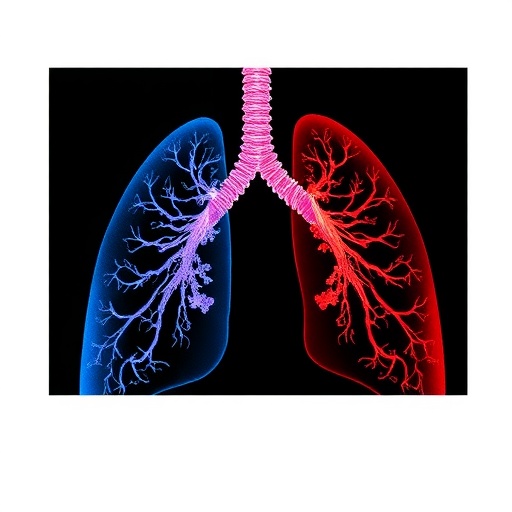Lung adenocarcinoma, a leading subtype of lung cancer, has long been known to be driven by various genetic aberrations. Among these, approximately five percent of cases are powered by a chimeric fusion between two genes: EML4 and ALK. This fusion, generating a constitutively active oncogenic protein, has historically been approached as a homogeneous entity in clinical settings. However, groundbreaking new research conducted by teams at the German Cancer Research Center (DKFZ) and Stanford University is challenging this paradigm, revealing significant biological and therapeutic disparities among different EML4-ALK fusion variants. These insights hold promise for transforming lung cancer treatment into a more personalized and effective endeavor.
At the molecular level, the fusion of EML4 (echinoderm microtubule-associated protein-like 4) and ALK (anaplastic lymphoma kinase) generates an abnormal protein that aberrantly drives cell proliferation and tumor progression in lung tissue. However, this fusion is not uniform; it occurs at varying breakpoints within the genes, producing several distinct variants with different lengths and structural conformations of the fusion oncoprotein. Until now, medical practitioners have administered the same targeted therapies to patients harboring any form of the EML4-ALK fusion, largely ignoring potential biological nuances among these variants.
Using advanced genome editing technologies, notably the CRISPR/Cas9 system, researchers engineered precise mouse models replicating the two most common human EML4-ALK fusion variants: variant 1 (V1) and variant 3 (V3). Their investigations unveiled a stark difference in tumor behavior initiated by these variants. Tumors driven by V3 manifested far more aggressive growth kinetics, producing larger tumor burdens at significantly accelerated rates compared to their V1 counterparts. Moreover, these V3-driven tumors led to markedly shorter survival times in mice, underscoring a profile of heightened malignancy and lethality.
This differential tumorigenic potential prompted an in-depth exploration of the interaction between fusion variants and the broader genetic context of tumor suppressor genes. Tumor suppressor genes are crucial gatekeepers, whose normal function helps restrain unregulated cell division and malignancy. The scientists evaluated the influence of twenty-nine known tumor suppressor genes on EML4-ALK-fusion-driven lung cancers, revealing variant-specific dependencies. Intriguingly, certain tumor suppressors exerted significant growth-inhibitory effects on the V1 tumors but displayed negligible impact on V3 tumors, and vice versa. This finding suggests that the molecular circuitry of tumor suppression is intricately modulated by the specific fusion variant present in the cancer.
Drug responsiveness, a critical determinant of therapeutic success, was also found to be variant-dependent. The researchers focused particularly on lorlatinib, a third-generation ALK tyrosine kinase inhibitor currently used in clinical practice. Cancer cells expressing the V1 fusion variant were generally much more sensitive to lorlatinib, exhibiting profound vulnerability. Conversely, cells harboring the V3 variant demonstrated a conspicuous resistance to this therapy. Genetic alterations beyond the fusion itself, such as loss-of-function mutations in the tumor suppressor gene PTEN, were observed to further modulate this drug sensitivity, often exacerbating resistance mechanisms. These findings highlight the complex interplay between fusion variants and co-occurring genetic changes in shaping treatment outcomes.
The translational significance of this research was corroborated by analyses of the most extensive dataset of EML4-ALK-positive lung cancer patients to date. Examination of patient tumor samples revealed that those bearing distinct fusion variants commonly harbored variant-specific patterns of co-mutations in other cancer-related genes. This genetic heterogeneity underscores the limitation of a “one-size-fits-all” therapeutic approach, emphasizing the need for variant-specific diagnostics and interventions in clinical oncology.
The study’s implications reverberate through the future landscape of precision medicine for lung adenocarcinoma. Current clinical protocols often treat all ALK fusion-positive patients uniformly, potentially contributing to variable and sometimes disappointing therapeutic responses. By distinguishing the fusion variants at diagnosis and tailoring treatments accordingly, clinicians may considerably enhance drug efficacy and patient outcomes. For the particularly aggressive and drug-resistant V3 variant, alternative therapeutic strategies or combination treatments may be warranted to overcome inherent resistance.
Moreover, the interplay between fusion variants and tumor suppressor gene status suggests that comprehensive genetic profiling could become a cornerstone of clinical decision-making. Beyond simply identifying the presence of the EML4-ALK fusion, detailed variant characterization combined with assessment of tumor suppressor landscapes may enable clinicians to predict disease progression trajectories more accurately and to customize multi-targeted treatment regimens.
This research not only illustrates the biological complexity underlying seemingly singular oncogenic events but also serves as a paradigm for how subtle genomic variations can drastically reshape tumor behavior and therapeutic vulnerability. As Rocío Sotillo, the study’s senior author at DKFZ, succinctly states, “Our results show that not all EML4-ALK fusions are the same. This could explain why some patients respond significantly better to therapies than others. In the long term, knowledge of the exact fusion variant could help to select treatments that are even more specifically tailored to the individual disease.”
The newly established mouse models engineered through CRISPR/Cas9-mediated gene editing represent powerful platforms for further mechanistic studies and preclinical drug testing. These models recapitulate human disease more faithfully than generic models and provide invaluable insight into how distinct molecular configurations of an oncogene influence tumorigenesis.
Support for this research was provided by prominent institutions including the German Center for Lung Research, Worldwide Cancer Research, and the US National Institutes of Health. The study’s findings were published in the high-impact journal Cancer Discovery, signifying its significance within the cancer research community.
In conclusion, this investigation into EML4-ALK fusion variants transcends traditional cancer genetics by revealing variant-specific tumor biology and therapeutic responses. It invites researchers and clinicians alike to rethink lung adenocarcinoma treatment through the prism of molecular subtypes, ultimately aiming to transform patient care through precision oncology. As targeted therapies continue to evolve, integrating detailed genomic insights such as these will be paramount to overcoming resistance, improving survival, and delivering truly personalized cancer treatment.
Subject of Research: Lung adenocarcinoma driven by EML4-ALK gene fusions and variant-specific tumor behavior and drug responses.
Article Title: EML4-ALK variant-specific genetic interactions shape lung tumorigenesis.
News Publication Date: Not explicitly provided (anticipated 2025).
Web References: http://dx.doi.org/10.1158/2159-8290.CD-24-1417
References: Alberto Diaz-Jimenez et al., Cancer Discovery, 2025.
Keywords: Lung adenocarcinoma, EML4-ALK fusion, gene variants, tumor suppressor genes, CRISPR/Cas9, targeted therapy, lorlatinib, drug resistance, precision oncology, tumorigenesis.
Tags: ALK fusion variantsCRISPR/Cas9 in cancer researchEML4-ALK gene fusiongenetic aberrations in lung cancerlung adenocarcinoma treatmentlung cancer research breakthroughsmolecular biology of lung canceroncogenic protein in lung cancerpersonalized lung cancer therapyprecision medicine in oncologytargeted therapies for lung cancertherapeutic disparities in ALK variants






